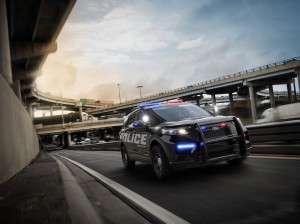
The hybrid version of the new 2020 Ford Police Interceptor gives officers instant torque when they need it.
If you see flashing lights in your rearview mirror in the coming months they just might be mounted on the 2020 Ford Police Interceptor Utility based on the all-new version of the big Explorer SUV Ford that will officially introduce at the North American International Auto Show later this month.
While there are some notable differences between the cop model and the one civilians will be able to buy, the Interceptor offers some big clues as to what’s to come with the 2020 Ford Explorer, starting with an all-new platform and the hybrid driveline that will also be offered on the retail model.
The Interceptor, however, will be offered only with the hybrid drivetrain, Ford officials told TheDetroitBureau.com during a sneak peek event ahead of the Explorer’s official Detroit debut. It’s something that “makes perfect sense for the law enforcement application where they’re idling 60% of the time,” explained Greg Ebel, the Interceptor’s marketing manager.
Ford has long been the dominant force in the police vehicle market, though its position came under threat when it decided to abandon the long-lived Crown Victoria sedan early in the decade. It came back with three alternatives based on the Fusion and Taurus sedans, as well as the Explorer. Now, with Ford planning to all but abandon the U.S. passenger car market, the automaker is looking for ways to make the Explorer-based Interceptor even more attractive to the law-enforcement community.
(Ford introduces new Police Responder version of F-150 pickup. Click Here to check it out.)
The hybrid drivetrain is a key part of that strategy. The system is based around a 3.3-liter naturally-aspirated V-6 paired with an electric motor, the combined package making 318 horsepower and 336 pound-feet of torque. The hybrid system is designed to deliver instant power, but it also promises to average 24 miles per gallon, according to Ford, or 41% more than the outgoing Police Interceptor Utility with a 3.7-liter gas engine.

The new Ford Police Interceptor Utility provides a slew of new technology as well as energy savings.
That actually understates the advantages of going hybrid, suggested Ebel. With pursuit vehicles spending most of their time idling, the new Explorer-based model will be able to have its engine shut down most of the time, power for onboard functions, including computers and radios, coming from the SUV’s lithium-ion battery pack. When the battery starts to drain, the engine will automatically fire up and help recharge the pack before shutting down again.
At $2.75 a gallon – about what gas had been averaging nationwide before the recent slump in pricing – Ford estimates a police department could save $3,500 a year thanks to the hybrid system. That could add up substantially for major agencies, such as the Los Angeles Police Department, which fields hundreds of Interceptors.
While Ford isn’t ready to discuss pricing, Ebel said the fuel savings alone should readily offset any premium for the hybrid package. And that doesn’t include the estimated savings on maintenance and repairs, Ford is predicting, by not having the engine run constantly.
The automaker has taken several other steps to enhance the appeal of the 2020 Interceptor. Unlike the three-row civilian Explorer, the cop version will have just two rows. That allows Ford to integrate a special safety cage designed to withstand a rear-end impact of up to 75 mph – the federal standard being just 50 mph.
(Click Here for more about Ford addressing concerns about previous Interceptor models.)
“The safety of the officer is our first concern, said Ebel.

The new Ford Police Interceptor Utility is designed protect officers from rear collisions as well as rear ambush attacks.
In most years, traffic accidents are the leading cause of death among officers on duty, not gunfire, according to federal data.
A few years ago, Ford introduced a system designed to detect when someone approaches one of its Interceptor Utility vehicles from the rear, helping officers avoid a potential ambush. The new model adds an updated version, dubbed Police Perimeter Alert. Using the rear parking assist system it can track the movements of someone approaching the Explorer from the rear “and can tell the difference between a jogger and an actual threat,” Ebel noted.
If a potential threat is detected, the system rolls up the vehicle’s windows, locks the doors and sounds an alert.
Ford became the first automaker to introduce a dedicated police package in 1950. It started using the Interceptor name a year later on a model equipped with its old flathead V-8 engine making 110 horsepower.
(To see more about Ford’s other police vehicle offerings, Click Here.)
Ford won’t discuss sales volumes or market share but independent data suggest it currently controls more than half of the U.S. market for dedicated police vehicles.
